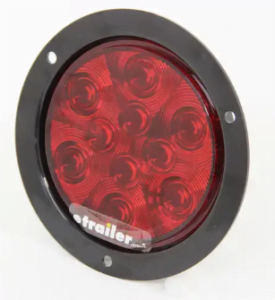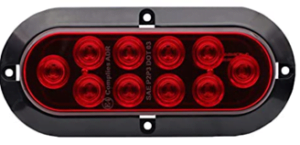By Bill Adams
This article is not intended to disparage, demonize, or criticize fire apparatus purchasers; apparatus and warning light manufacturers; or any entity that governs, regulates, or mandates the design of fire apparatus. It addresses some misconceptions about the sizes (footprints) and locations for warning lights that protect and identify the rear of a fire truck. In a previous posting it was mentioned that fire apparatus manufacturers (OEMs) appear reluctant to change or modify the standard warning light packages they offer. This writer’s opinion is that it is “legal” for them to do so, and they should when requested by the fire department, provided “compliance” is maintained.
The area behind a rig covered by upper- and lower-level warning lights is designated Zone C by the National Fire Protection Association NFPA 1901 Standard for Automotive Fire Apparatus (NFPA 1901). Unless adopted as law by a political subdivision, NFPA 1901 and its future replacement NFPA 1900 are voluntary nationwide consensus standards. Often, NFPA requirements are only adhered to when there’s a possibility of litigation if they’re not followed and “something bad happens.”
There is no debate or questioning NFPA 1901 requirements for the number and generic locations of warning lights; or the methods of testing the devices; or the minimum optical power requirements per light, per level, or per zone. Optical power requirement is often referred to as the overall efficacy of the light—meaning its brightness or visual effectiveness. Those requirements are irrelevant for this discussion. Before warning lights can be addressed, purchasers should be cognizant of the basic chassis lighting mandated by Federal law.
DOT & FMVSS 108
NFPA 1901 lighting requirements take second place to those of the Federal Motor Vehicle Safety Standard 108 (FMVSS) which regulates all automotive lighting, signaling, and reflective devices in the United States. FMVSS falls under the auspices of the United States Department of Transportation (DOT). Its requirements are law. The very similar Canadian version is the Canadian Motor Vehicle Safety Standard (CMVSS) covered under Section 108 of that country’s Motor Vehicle Safety Regulations. Apparatus OEMs are obligated to follow FMVSS regulations for chassis lighting.
Rear DOT Lights
Rather than researching and regurgitating the maze of FMVSS lighting regulations, TruckLite Corporation’s website is referenced. It says FMVSS defines tail lamps as indicating a vehicle’s presence and width; stop lamps indicates breaking; and turn signal or hazard warning lamps indicates direction of turn and identifies a disabled vehicle. It goes on to say there must be a minimum of two each: “Rear-symmetrical as far as practicable” and located between 15 inches and 72 inches from the ground.
A definition of being symmetrical is “correspondence in size, shape, and relative position of parts on opposite sides of a dividing line or median plane or about a center or axis.” Simply put: Whatever’s on the vehicle’s rear left side must match what’s on the rear right side. That’s law. “Being symmetrical” only pertains to FMVSS mandated lights—not NFPA warning lights.
FMVSS does not require rear chassis lights to be stacked vertically, although apparatus OEMs commonly do vertically stack stop, tail, turn signal, and back-up lights on each side. But, they don’t have to be (Photos 3, 4 and 5). FMVSS only requires one back-up light but doesn’t specify a location for it. Often, a warning light is added stacking five lights one above the other.
A common chassis and warning light fixture is 4-inch by 6-inch, although that is not a requirement. An apparatus vendor saying that particular size and an exact location is a DOT or NFPA requirement is being disingenuous. It might be the OEM’s standard size and location, but it isn’t the DOT’s or the NFPA’s.
DOT Light Sizes
Ken Menke III, the owner of PowerArc, a Missouri-based warning light company, provided some generic comment on warning and chassis lights. He can put technical lighting terminology into simple, understandable terms. When asked about light sizes (dimensions), he responded, “Size does not matter when looking at LED warning lights and housings. The same applies to DOT-required chassis lighting. Light performance is based on optics and performance of the LED. Figures 1 through 3 show different 4-inch round DOT compliant LED brake lights. All are the same size (footprint) and produce the same amount of light required by FVMSS, but all use different numbers of and types of LED’s. You can have the same light output with 1, 10, or 21 LEDs.” As further example, Figures 4, 5, and 6 depict different-shaped smaller LED lights that are equal in performance.
To the best of this writer’s knowledge, FMVSS does not have a specific size (footprint) requirement for its lights. Ask the apparatus OEMs—they should know. While you’re at it, ask them what the minimum optical power requirements are for chassis lighting. They’re required to meet that also.
This writer does not advocate or recommend the mandatory use of small-sized FMVSS lighting on fire apparatus, although some OEMs occasionally use them (Photo 1). Small-sized, circular-shaped lights about 4 inches in diameter are popularly used elsewhere. Where? Online research reveals the United States Postal Service has about 200,000 vehicles; the United Parcel Service has about 120,000; and there are around 5,000,000 trailers (the tractor-trailer type) in the United States. The next time you’re behind one, check their light sizes and locations. Maybe what’s good for the goose can work for the gander.
NFPA 1901 Zone C Lighting Locations
The three basic locations for rear warning lights are: Where the purchaser wants them; where the apparatus OEM wants to locate them; and where the NFPA says they “shall be” located. Utopia is when the chosen location keeps everyone happy.
For upper-level warning lights on the front, rear, and both sides, NFPA 1901 sentence 13.8.13.2.1 states: “The upper-level optical warning devices shall be mounted as high and as close to the corner points of the apparatus as is practical to define the clearance lines of the apparatus.
For lower-level warning lights on both sides and rear, NFPA 1901 sentence 13.8.13.3.2 states: “The optical center of the lower-level optical warning devices at the rear of the vehicle shall be mounted on or behind the rear axle centerline and as close to the rear corners of the apparatus as is practical. NFPA 1901 sentence 13.8.13.3.3 states for larger fire apparatus: “The optical center of any lower-level device shall be between 18 in. and 62 in. (460 mm and 1600 mm) above level ground.”
There are a couple noteworthy items. The first is the actual height of lower warning lights cannot be higher than 62 inches from the ground. Taking for granted a fire truck’s body starts around 24 inches from the ground, there’s a three-foot vertical window to locate the warning lights on the apparatus body—if the OEM acquiesces.
The second is the NFPA’s use of the term “as is practical” when locating warning lights close to all the corner points and the top of the apparatus. Practical can be defined as realistic, sensible, and feasible. “As is practical” rests in the eyes of the beholder; consequently, there’s wiggle room in locating them—again, if an OEM is willing to do so.
Contrary to popular belief, the warning lights on a fire truck do not have to be symmetrical in location. Nor do they have to be identical in size or configuration. Photo 2 illustrates Ken Menke’s statement that “The fire service has been doing symmetrical rear lights since the day of the lantern.”
***
The rear ends of most pumpers are very busy workplaces. There’s a lot going on in a very limited space. Apparatus manufacturers’ “standard” or preferred locations to mount chassis and warning lights could inadvertently dictate the fireground efficiency and functionality of the apparatus. Purchasers ought to consider looking “outside the box” of the status quo lighting locations presented by the vendors. As long as light locations meet FMVSS and/or NFPA 1901 criteria, why not locate them so they work with you and not against you? Continued in part 2.

Figures 1 through 6 and photos 1 and 2 from the internet were provided by Ken Menke III.
















